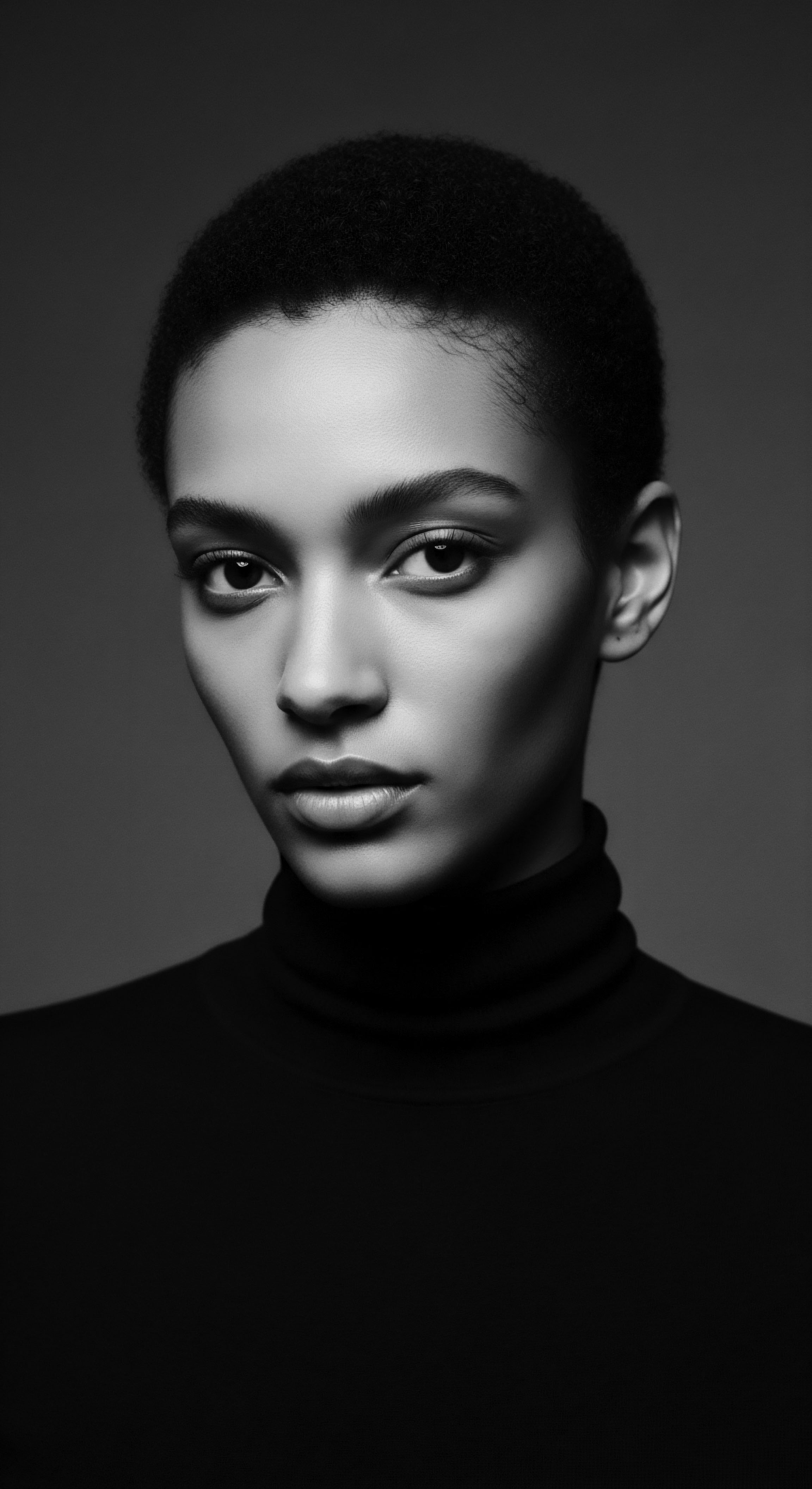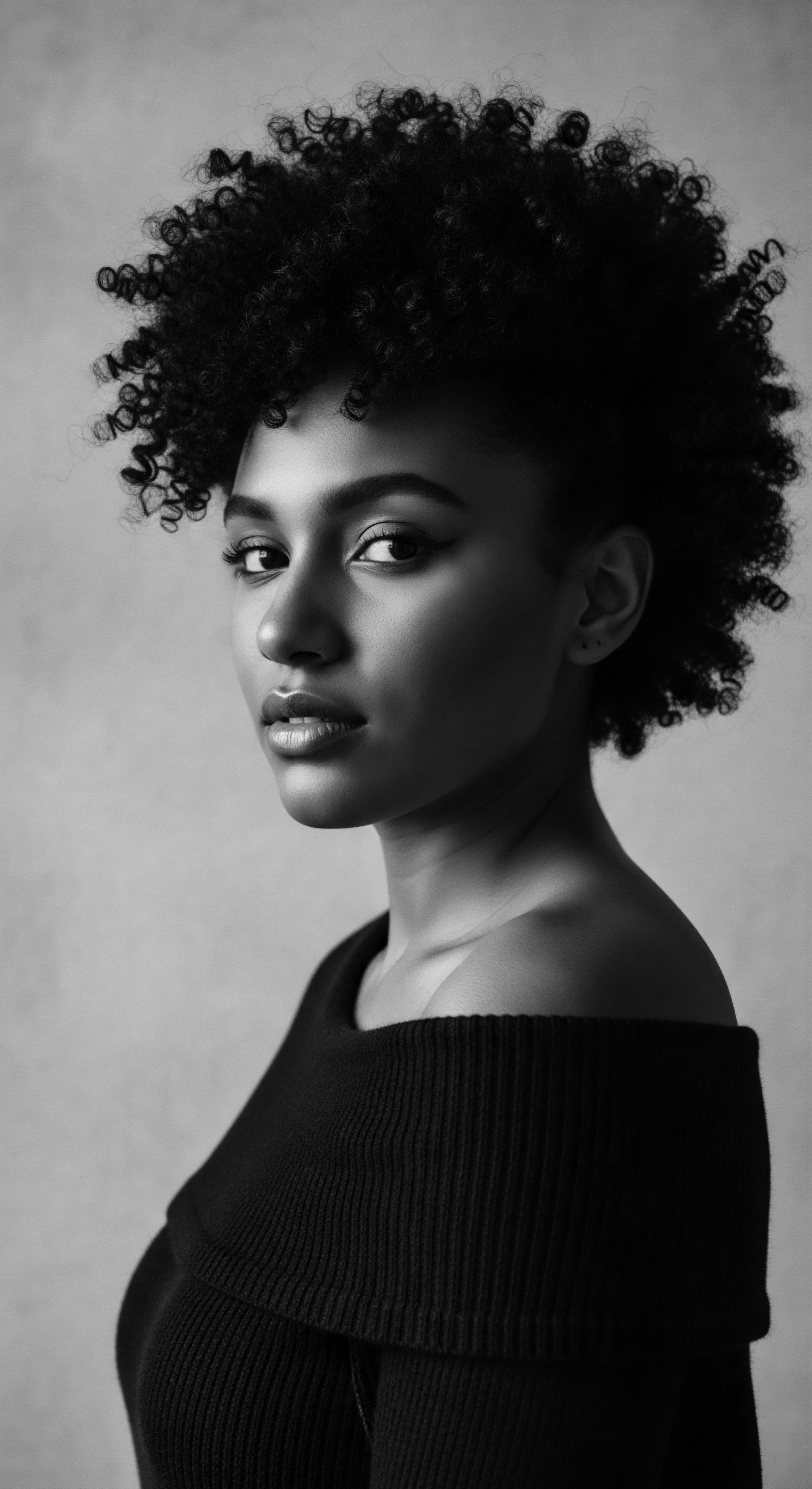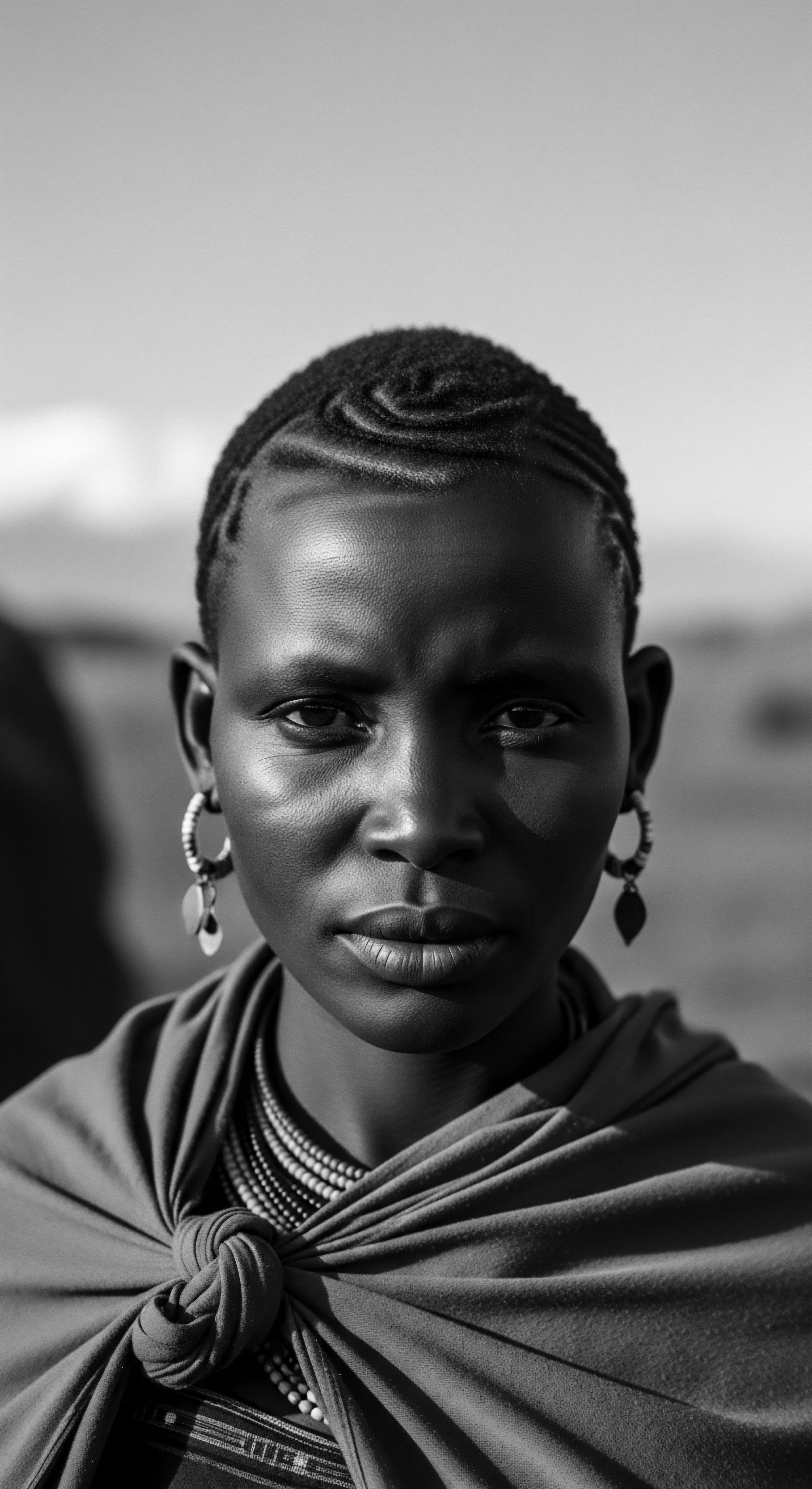
Roots
The story of textured hair is an ancestral chronicle, a testament to enduring beauty and resilience woven into the very being of Black and mixed-race communities across the globe. Before the tumultuous arrival of colonial ships, the coils and kinks that crown the heads of African peoples held profound significance, functioning as a vibrant visual language. Hair was far more than simple adornment; it was a living map of identity, a canvas reflecting social standing, age, marital status, spiritual beliefs, and tribal affiliation.
Each intricate braid, every artfully sculpted coil, spoke volumes about a person’s place within their community and their connection to the unseen world. Communal grooming rituals, often spanning hours, fostered deep bonds, transmitting ancestral wisdom and cultural practices from one generation to the next.
Consider, for instance, the Yoruba people of Nigeria, whose detailed styles communicated community roles with specific clarity. Or the Himba tribe of Namibia, their locs covered in red ochre paste, signifying a profound connection to the earth and their ancestors. In many African societies, the head itself was revered as the most elevated part of the body, a conduit for spiritual energy, a point of entry for divine wisdom.
The care given to hair, therefore, was not merely cosmetic; it was a sacred practice, a communion with heritage and a manifestation of spiritual alignment. This understanding of hair as a profound marker of selfhood was brutally disrupted by the advent of European colonialism and the transatlantic slave trade.
The arrival of colonizers introduced a discordant note into this vibrant symphony of hair culture. One of the initial acts of dehumanization inflicted upon enslaved Africans involved the forced shaving of their heads upon arrival in the Americas. This act, disguised as a measure for hygiene on crowded slave ships, served a far more sinister purpose.
It was a deliberate, violent erasure of identity, a systematic stripping away of cultural memory and self-worth. The hair, once a proud symbol of lineage and belonging, was reduced to something to be shorn, an obstacle to the subjugation of the individual.
The imposition of European beauty standards began to cast a long shadow, transforming textured hair from a source of pride into a marker of inferiority. Early colonial views were deeply steeped in emerging pseudo-scientific racial theories that sought to justify systems of hierarchy and domination. During the 18th and 19th centuries, scholars such as Carl Linnaeus, in his foundational work Systema Naturae, classified human populations, assigning “Africanus” with “tight curls”. This categorization, alongside others, presented physical characteristics as immutable biological facts.
Charles White, an English physician, published an early “scientific” study in 1799, measuring various body parts, including hair texture, to support a hierarchical gradation of races, placing Europeans at the apex. These falsified scientific hypotheses were instrumental in providing a supposed biological basis for racial distinction, cementing the idea that certain hair textures were inherently “lesser”.
The biological reality of textured hair—its unique coil patterns, its tendency towards dryness, its need for specific moisture retention—was reinterpreted through a distorted lens of racial bias. What was a natural variation became a flaw, something “unruly” or “unmanageable.” This pathologizing of textured hair was not accidental; it was a foundational element in establishing a social order where those with African heritage were positioned at the bottom. The very essence of hair, its structure and growth, was redefined by this new, oppressive gaze.
The journey of textured hair began as a profound cultural expression, disrupted by colonial impositions that sought to dismantle identity through forced shaving and pseudo-scientific denigration.
Within this oppressive climate, the foundational understanding of textured hair—its anatomical variations, its distinct needs—became obscured. Traditional lexicons, rich with terms that described hair types and care practices within specific African cultures, were suppressed. The focus shifted from celebration and maintenance to control and alteration.
- Yoruba ❉ Intricate hairstyles indicating social roles and spiritual connections.
- Himba ❉ Locs coated with red ochre, signifying ancestral and earth bonds.
- Maasai ❉ Hair arrangements linked to spiritual energy and community standing.
The deliberate shaving of hair upon arrival in the “New World” represented more than a physical alteration; it was a symbolic act of cultural obliteration. It was a declaration that the individual’s past, their heritage, their very essence, was to be stripped away, replaced by a new, debased identity within the system of enslavement. This early colonial view laid a foundational stone for the enduring bias against textured hair, disconnecting individuals from their ancestral hair practices and implanting a sense of inferiority.
This redefinition extended to the physical characteristics of textured hair itself. The tightly coiled structures, which in their natural state defied gravity with spirited volume, were framed as problematic. Scientific racism sought to codify these perceived differences, lending an air of authority to baseless claims of inferiority. This distorted “understanding” became a tool of social engineering, dictating who was “civilized” and who was not, who was “beautiful” and who was not.

Ritual
From the deliberate acts of stripping identity, colonial views progressed to a systematic manipulation of the very rituals of care and styling that defined textured hair heritage. The imposition of European beauty standards was not subtle; it was a pervasive pressure that permeated every aspect of daily life for Black and mixed-race individuals. This pressure manifested in societal expectations, often backed by coercive measures, which sought to alter the natural appearance of textured hair to align with a singular, Eurocentric ideal of straightness and smoothness.
The traditional practices that nurtured textured hair—the communal braiding sessions, the application of natural oils and butters passed down through generations—were actively discouraged or made impossible under the harsh realities of enslavement. Time, once dedicated to intricate styling and bonding, became a luxury denied. Enslaved individuals were often forced to cover their hair or adopt simplified, often damaging, grooming practices that mimicked the styles of their captors. This suppression of traditional hair care was a strategic maneuver to dismantle cultural cohesion and reinforce the notion of inferiority.
A powerful historical example of this colonial control over hair expression comes from 18th-century Louisiana, where the Spanish Governor Esteban Rodríguez Miró enacted the infamous Tignon Laws in 1786. New Orleans, during this period, was home to a notable population of free Black women, many of whom were renowned for their elaborate and artistic hairstyles, adorned with jewels, feathers, and ribbons. Their striking appearances, which openly displayed their hair’s natural beauty and creativity, attracted considerable admiration, including from white men. This posed a perceived threat to the established social order and challenged the racial hierarchy.
The Tignon Laws, enacted in colonial Louisiana, represented a direct legislative effort to suppress the visible expression of Black women’s hair heritage and assert white dominance.
The Tignon Laws mandated that free Black women cover their hair with a tignon, a headscarf or handkerchief. The clear purpose was to distinguish them from white women and visually tie them to the enslaved class, regardless of their free status. Governor Miró’s intent was to control women whom he believed exhibited “too much luxury in their bearing” and competed too freely with white women for status. The law was an explicit attempt to diminish their beauty and social standing by concealing a prominent feature of their allure.

Did the Tignon Laws Succeed in Suppressing Identity?
Despite the oppressive intent behind the Tignon Laws, the ingenuity and spirit of the free Black women of Louisiana transformed this symbol of subjugation into a statement of defiance and artistic expression. They adopted the tignon, certainly, but they did so with vibrant, costly fabrics, tying them in elaborate knots and decorating them with feathers and precious stones. This act of sartorial rebellion turned a mandated mark of inferiority into a celebrated symbol of their enduring beauty, wealth, and creativity.
The tignon, meant to signal a lower status, instead became a declaration of pride, a quiet but powerful act of resistance against a colonial government determined to control their appearance. Their ability to reinterpret the law without technically breaking it underscores the deep connection between hair, personal autonomy, and collective heritage.
| Colonial Practice Forced head shaving upon arrival in the Americas |
| Heritage Response Subtle re-creation of styles; expression through available means |
| Colonial Practice Classification of textured hair as "inferior" or "unruly" |
| Heritage Response Preservation of traditional grooming practices, often in secret communal gatherings |
| Colonial Practice Tignon Laws mandating head coverings for free Black women |
| Heritage Response Adornment of head coverings with luxurious fabrics, jewels, and elaborate ties, turning restriction into fashion |
| Colonial Practice Pathologizing of natural hair as "unprofessional" |
| Heritage Response Development of specific techniques and tools for managing textured hair with limited resources |
| Colonial Practice The colonial era saw systematic attempts to control Black hair, yet these efforts were met with persistent acts of cultural preservation and ingenious defiance rooted in ancestral practices. |
The impact of these views resonated deeply, establishing a dichotomy of “good hair” versus “bad hair” that persisted for centuries. “Good hair” became synonymous with straighter, looser curl patterns, closer to European textures, often associated with perceived proximity to whiteness or higher social standing within the enforced racial hierarchy. Conversely, tightly coiled or kinky textures were branded as “bad,” “nappy,” or “unprofessional,” perpetuating negative stereotypes and contributing to internalized biases.
Despite immense pressure, Black people developed innovative methods to care for their hair with the limited resources available. Communal grooming, often taking place on Sundays—the only day of rest for enslaved people—became a cherished tradition, a space for shared experience and cultural continuity. Tools fashioned from wood, bone, or salvaged metal, alongside natural ingredients like shea butter and coconut oil, were adapted to maintain hair health and style, silently carrying forward fragments of ancestral wisdom. This resourcefulness demonstrates the unwavering commitment to heritage, even when confronted with overwhelming oppression.

Relay
The echoes of early colonial views on textured hair persist, reverberating through contemporary perceptions, practices, and even scientific understanding. The legacy of pseudo-scientific racism, which sought to quantify and categorize human differences to justify hierarchy, continues to cast a long shadow. The arbitrary assignment of “inferiority” to textured hair, born from a desire to rationalize enslavement and control, morphed into deeply ingrained societal biases. These historical distortions inform global beauty standards, often elevating Eurocentric features while devaluing the inherent qualities of coils, kinks, and waves.
The concept of race itself, a social construct devoid of biological foundation, was meticulously crafted during the European Age of Exploration to facilitate domination. Within this framework, hair texture became a primary determinant in racial classification systems, used to establish hierarchies where those of African descent were positioned at the lowest rung. This historical manipulation of biological traits for social control explains why, even today, race-based hair discrimination remains a persistent issue in workplaces, schools, and social settings.

How does This Historical Bias Manifest in Modern Hair Care?
The ingrained bias often pushes individuals with textured hair towards chemical straighteners and heat styling, methods historically associated with “taming” or “conforming” hair to European standards. This preference for straightened hair, a direct consequence of colonial beauty ideals, has significant implications for hair health. Chemical straighteners, commonly known as relaxers, contain potent chemicals that can cause damage to the hair shaft and scalp, and some studies suggest links to adverse health outcomes.
A 2023 survey found that a notable percentage of Black respondents used chemical straighteners because they “felt more beautiful with straight hair,” illustrating the persistent internalization of these historically imposed beauty norms. This speaks to a profound disconnection from hair’s ancestral state, shaped by centuries of societal conditioning.
The commercial beauty industry, for a considerable period, mirrored these biases. Products and marketing often prioritized achieving straight hair or defining loose curls, overlooking the unique needs and celebrated variations of tightly coiled textures. This contributed to a lack of resources and knowledge for authentic care rooted in textured hair’s natural biology and heritage. The very act of seeking information about textured hair care often required navigating spaces designed around a different hair paradigm, a subtle but constant reminder of the historical devaluation.
Yet, against this backdrop of historical suppression, the spirit of resistance and reclamation has surged forth. The modern Natural Hair Movement, building upon the foundations laid during the Civil Rights Movement of the 1960s and 70s, represents a profound re-engagement with textured hair heritage. This movement encourages individuals to discard chemical processes, embrace their natural textures, and redefine beauty on their own terms, rooted in ancestral pride. It is a collective act of restoring cultural memory, celebrating diversity, and honoring the hair that was once denigrated.
- Ancestral Oils ❉ Shea butter, coconut oil, aloe vera, and other natural plant derivatives, long used in African communities for nourishment and scalp health, are experiencing renewed prominence.
- Protective Styles ❉ Braids, twists, and locs, deeply rooted in African traditions, are celebrated not merely as styles but as methods for preserving hair health and connecting with lineage.
- Community Gathering ❉ The act of hair care, once a communal activity, is being revived in new forms, fostering shared knowledge and strengthening bonds within the diaspora.
This reawakening is not merely about aesthetics. It is a powerful statement of identity, a rejection of oppressive legacies, and a conscious return to practices that acknowledge the inherent beauty and resilience of textured hair. It asserts that hair is a symbol of self-acceptance, a visible link to a vibrant and unbroken heritage. The movement validates what pre-colonial African societies always understood ❉ hair holds meaning beyond its physical form; it is a repository of history, a vessel of culture.
The journey of textured hair reveals a constant interplay between historical bias and a tenacious spirit of reclamation, a testament to its enduring role as a cultural marker.
The ongoing pursuit of legislative protections, such as the CROWN Act in the United States, aims to address the systemic discrimination that still impacts individuals with textured hair. These legal frameworks acknowledge that biases rooted in colonial views continue to affect opportunities and well-being. The fight for the right to wear one’s hair naturally, without fear of professional or social repercussions, is a direct consequence of the historical devaluation of textured hair.
Understanding the journey of how early colonial views shaped bias against textured hair illuminates the profound cultural and social implications that extend into our present moment. It reveals a lineage of control, resistance, and ultimately, a powerful reclamation of heritage. This understanding allows for a deeper appreciation of the living archive that is textured hair, and the enduring strength of the communities who wear it with pride.

Reflection
The narrative of textured hair, from its revered place in ancient African societies to its contested status under colonial rule and its powerful resurgence today, underscores a profound truth ❉ hair is an undeniable extension of self, a living archive of heritage. The colonial gaze, with its pseudo-scientific classifications and deliberate acts of denigration, sought to sever the deep connection between Black and mixed-race peoples and their crowning glory. Yet, as the Tignon Laws vividly illustrate, the human spirit, especially when rooted in ancestral wisdom, finds ways to defy suppression, transforming tools of oppression into symbols of liberation.
The path from forced shaves to celebrated Afros, from concealed tignons to adorned locs, reflects a journey not just of follicles, but of collective consciousness. It speaks to the enduring power of cultural memory, passed down through whispers, communal rituals, and the silent language of perseverance. Each coil, every kink, holds the stories of those who came before, a tangible link to a heritage that refused to be erased.
This living library of textured hair continues to write its chapters, inviting us to look beyond superficial appearances and recognize the profound history, the strength, and the undeniable beauty held within each strand. It is a continuous narrative of identity, resilience, and the soulful affirmation of one’s authentic self, deeply connected to the wellspring of ancestral knowledge.

References
- Byrd, A. D. & Tharps, L. (2014). Hair Story ❉ Untangling the Roots of Black Hair in America. St. Martin’s Griffin.
- Gould, V. M. (1996). The Devil’s Lane ❉ Sex and Race in the Early South. Oxford University Press.
- Long, C. (2001). Creole Ladies and the Tignon ❉ Antebellum New Orleans and the Regulation of Women of Color. The Journal of American Culture, 24(2), 27-33.
- Omotoso, S. A. (2018). Human Hair ❉ Intrigues and Complications. Journal of Pan African Studies, 12(8), 1+.
- Parris, L. (2015). Being Apart ❉ Theoretical and Existential Resistance in Africana Literature. University Press of Mississippi.
- Robinson, L. (2011). The Soul of Black Hair ❉ A Cultural History. St. Thomas University.
- Thompson, E. C. (2008). Beauty in a Box ❉ The Other Black Women in the Hair Care Industry. Journal of American Culture, 31(1), 77-88.
- Winters, Z. (2015). The Mulatta Concubine ❉ Terror, Intimacy, Freedom, and Desire in the Black Transatlantic. University of Georgia Press.
